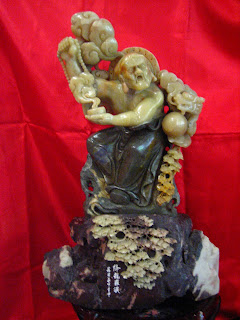十八罗汉成员

十八罗汉 是指佛教传说中十八位永住世间护持正法的阿罗汉。 十八罗汉 是十六罗汉加二尊者而来的, 十八罗汉 原只有十六罗汉,都是释迦牟尼的弟子,均是历史人物。十六罗汉主要流行于唐代,至唐末,开始出现 十八罗汉 ,到宋代时,则盛行 十八罗汉 了。 十八罗汉 的出现;可能与中国文化中对十八的传统偏好有关。 1. 降龙罗汉 :庆友尊者,传说曾降伏恶龙。 2. 坐鹿罗汉 :宾罗跋罗多尊者,曾乘鹿入皇宫劝喻国王学佛修行。 3. 举钵罗汉 :迦诺迦跋厘隋阁,是一位托化缘的行者。 4. 过江罗汉 :跋陀罗尊者,过江似蜻蜓点水。 5. 伏虎罗汉 :宾头卢尊者,曾降伏过猛虎。 6. 静坐罗汉 :诺距罗尊者,又为大力罗汉,因过去乃武士出身,故力大无穷。 7. 长眉罗汉 :阿氏多尊者,传说出生时就有两条长眉。 8. 布袋罗汉 :因揭陀尊者,常背一布袋笑口常开。 9. 看门罗汉 :注茶半托迦尊者,为人尽忠职守。 10. 探手罗汉 :半托迦尊者,因打坐完常只手举起伸懒腰,而得此名。 11. 沉思罗汉 :罗怙罗尊者,佛陀十大弟子中,以密行居首. 12. 骑象罗汉 :迦理迦尊者,本是一名驯象师。 13. 欢喜罗汉 :迦诺伐蹉尊者,原是古印度一位雄辩家。 14. 笑狮罗汉 :罗弗多尊者,原为猎人,因学佛不再杀生,狮子来谢,故有此名。 15. 开心罗汉 :戍博迦尊者,曾袒露其心,使人觉知佛于心中。 16. 托塔罗汉 :苏频陀,是佛陀所收最后一名弟子,他因怀念佛陀而常手托佛塔。 17. 芭蕉罗汉 :伐那婆斯尊者,出家后常在芭蕉树下修行用功。 18. 挖耳罗汉 :那迦犀那尊者,以论“耳根清净”闻名,故称挖耳罗汉。